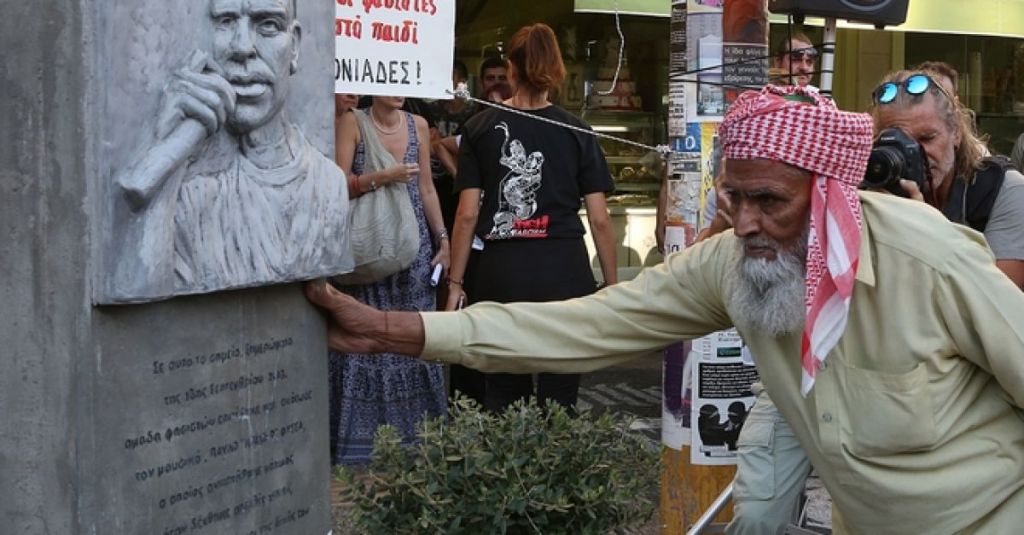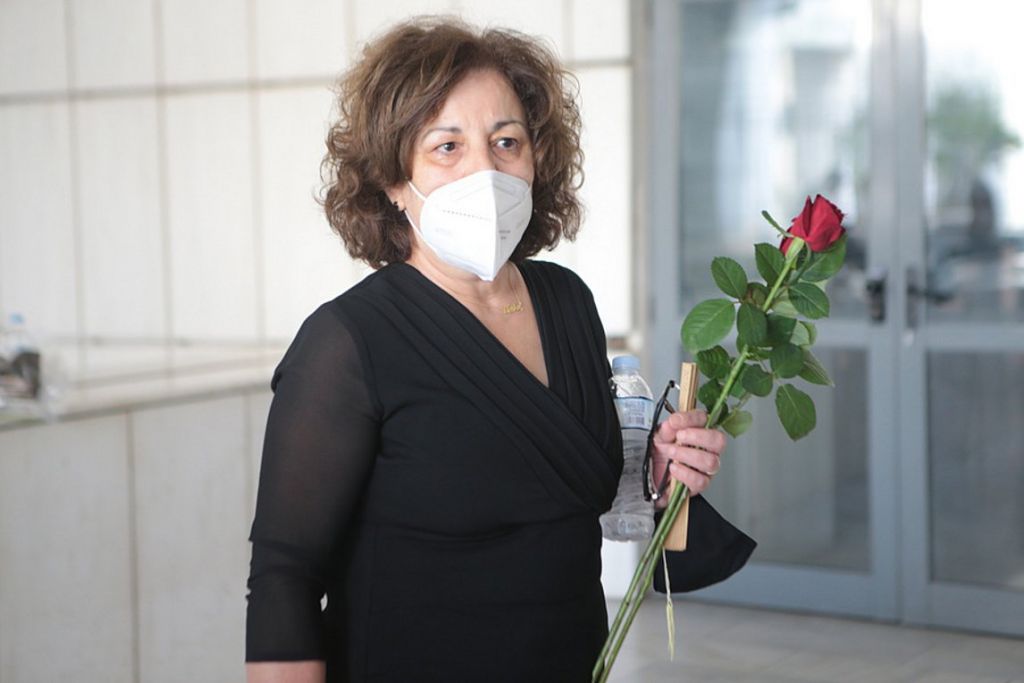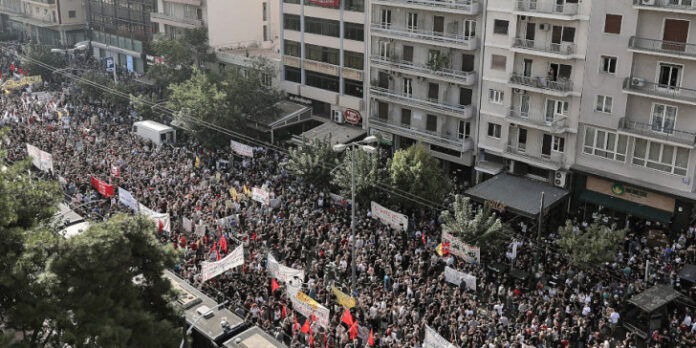October 7 is a day of historical importance for the working class, the anti-fascist movement and the social movements in Greece. The trial of Golden Dawn (GD) came to its conclusion and the neo-Nazi organization was convicted for what it is: a criminal gang of fascist thugs and murderers. For the anti-fascist movement, the verdict was a vindication of a struggle that has been going on for years – and even decades. For the tens of thousands of workers and youth who gathered outside the courts it was a moment of great joy – of cheers and chants but also of tears.
For the forces of conservatism and reaction it was a moment of grief. This was actually reflected in the behavior of the riot police (which it’s known for its links to the far right and GD itself) who only seconds after the verdict was announced launched a fierce attack with water cannons and tear gas against the mass protest, without any provocation (apart from a few small semi-empty plastic water bottles who were thrown at them by demonstrators). They chased demonstrators up to 1 km away from where the protest was taking place.
The protest outside the courts on the morning of Wednesday October 7, was in the region of 30 to 40,000. It was the biggest anti-fascist demonstration in the last three decades, even bigger than the demonstrations immediately after the murder of Pavlos Fyssas in September 2013.
The real aims of the ruling class
The trial started 5.5 years ago, it went through 454 court sessions, and until the very end, i.e. the final day of the trial, the outcome was unclear.
From the very beginning it was clear that the ruling class and the state were trying to play down the murderous role of GD. The murder of Pavlos Fyssas (an antifascist singer) was initially presented by the media… as a quarrel between different football fans!
When the reality of the political motives behind the murder could no longer be hidden the state had to take action and drug GD to trial. But from the beginning, the whole attempt of the police, the judiciary, the media, etc., was to present the murder as a result of the acts of one irresponsible individual, the executioner Rupakias. GD was allowed to continue its political activities despite the crushing evidence about its murderous role.
The media –press, radio and TV– controlled by the ruling class, behaved in the course of all the past years as if no trial was taking place, as if no neo-Nazi organization was being put on trial!
Last but not least, the public prosecutor, last December (2019) proposed that with the exception of the executioner Rupakias, the rest of the 68 accused leaders and cadre of the neo-Nazi organization should be freed and declared “non guilty”! She claimed that the leadership of GD was not responsible for Rupakias’ actions and that GD was not a criminal organization!
However, in the course of the trial the evidence about the character of GD was crushing. The leadership was involved in numerous crimes. The case of Sahzat Lukman, a 27-year manual worker from Pakistan, who had been murdered by GD thugs in January 2013, became widely publicized – and the murderers, GD members, were convicted to jail. Golden Dawn launched regularly murderous attacks against immigrants using knifes, iron bars etc. Some of the attacks, launched even in the commercial center of Athens were caught on video by people passing by. Nobody can know how many migrants were actually killed by GD.

Numerous videos and photographs provided undisputable evidence about the character of the organization – its armed wing, its military training, its Nazi ideology and symbols, it’s murderous attacks not only against migrants but also against trade unionists, left and LGBT activists, anarchists etc.
The aim of the ruling class through this trial was quite clear: to put checks on GD, to cut its dynamic and severely weaken it, but not to destroy it. They had good reason for this: at the time of the great movements of the Greek working class between 2010 and 2013 against the Troika and the Memoranda, GD played the role of the heavy hand of reaction against the movement using its thugs and paramilitary forces, doing what the official state could not have done without overcoming the boundaries of official parliamentary democracy and the Constitution. In times of crisis and mass revolt fascist thugs are always extremely useful to the system – not least to provide a radical political alternative to convulsing society from a right-wing perspective, so as to undermine the turn to radical left policies.
The Left attacked – but no reaction
At the high point of its strength, when its appeal was in the region of 14% in the polls, in 2013 (having received 7% in the elections of 2012) GD was “ruling the streets” of a number of areas in Athens and other big cities, presenting a real threat to the whole of the Left and to the activists of all social movements.
They had the audacity to attack not only individuals but official stalls and offices not only of the anti-capitalist Left but also of the mass parties of the Left, the Communist Party and SYRIZA!
Only days before the murder of Pavlos Fyssas, GD had attacked a group of Communist Party (KKE) trade unionists in the docs, in the working-class neighborhood of Perama in Pireaus, sending a number of them to hospital with very serious injuries. It was only by pure luck that nobody died. In the elections of June 2012 golden dawn had attacked and destroyed election stalls of all the parties of the Left who stood in the elections. These are aside the numerous attacks against migrants, as for example the murderous attack against a group of Egyptian fishermen in June 2012, which was very prominent in the course of the trial.
Yet the “official Left”, i.e. KKE and SYRIZA, did nothing essentially to stop GD. The Communist Party with its long roots in the working class and the youth and its thousands of self-sacrificing members, had the power to smash GD if it wanted. They never developed any serious anti-fascist struggle. After the attack against is trade unionists in Perama, Piraeus the only thing they did was to organize a local demonstration which reminded more of a funeral rather than of militant anti-fascist resistance. SYRIZA, on the other hand, always underestimated the significance and the dangers of the rise of GD – their main argument was that it was just a bubble that was going to fizzle out…
Who built the antifascist movement?
So essentially the anti-fascist movement was built by forces of the anti-capitalist left, one of them being Xekinima (ISA in Greece) and the family of Pavlos Fyssas and particularly his mother, Magda, who developed into and still is a key symbol of antifascist and social struggle in Greece.

Xekinima, was the first political organisation to propose the creation of the “Anti-fascist coordination of Athens and Piraeus” two months before the murder of Pavlos (in June 2013). In the aftermath of Pavlos’ murder the “Antifascist Coordination” was able to build or link with antifascist committees and assemblies in a total of 65 cities and towns in Greece.
As time went on, GD found itself in a bigger and deeper crisis. It split into three organizations and it lost a lot of its electoral support. In the elections of 2019, it failed to enter parliament and this further aggravated its crisis. Given the crisis of GD big sections of the population and the youth considered the fascist danger to have receded. The anti-fascist movement went through a period of retreat and the majority of local committees and assemblies closed down. Also, given the sectarianism of the Greek Left, the “Anti-fascist Coordination” entered a period of serious difficulties – but it managed to survive this difficult period which was combined with the general retreat of the mass movements as a result of SYRIZA’s capitulation after 2015.
The “Antifascist Coordination” was able to survive essentially due to the determined efforts of Xekinima and a couple of other left organizations which understood the necessity to keep the broad anti-fascist front alive because it would be needed in the future as GD and neo-fascism were far from finished. By following the court procedures closely, we could fully understand the real dangers that existed. The state and the judiciary wanted golden dawn to have a soft landing.
“They are not innocent – put the Nazis in jail”.
In January 2020 Xekinima and other anti-fascist activists responded to the proposal of the public prosecutor (as mentioned above, in December 2019) to declare GD “not guilty”, by proposing to start a new campaign as the trial was approaching its conclusion. The aim should be to go out as brought as possible and mobilize forces to exert pressure on the state and the judges. The campaign acquired the name “They are not innocent, put the Nazis in jail”.
It started off well but it was interrupted by the pandemic. Since the end of August however, after the summer holidays and after the lockdown was over, the campaign started with a new dynamic. Every effort had to be made to force the judges decide “guilty” for the leadership of golden dawn. If this was not the case then the neo-Nazis would be emboldened, they would be coming back with increased determination and audacity, they would take advantage of the new economic crisis, they would blame migrants and refugees once again for the problems, they would “invest” on nationalism given the extreme tensions in Eastern Mediterranean, they would once again use desperate impoverished elements to attack activists and migrants – having always the cover of the police in which there is huge infiltration by the far right (in the elections of June 2012 around 50% of the police voted for GD).
The campaign “They’re Not innocent – put the Nazis in jail” stroke a cord in society. It reached tens of thousands and different groups and individuals approached the campaign, sought contact and looked for ways to develop it.
An average of 15 groups or individuals per day, including unions of the base, were contacting the campaign in the weeks before the final session of the trial, the number reaching a daily maximum of 45 in the last days. It was clear that society was following the trial, despite the absolute silence of the mass media, and tens of thousands of activists wanted to see the Nazis in jail.
A pan-democratic front?
And then of course the establishment, its political parties, media and institutions, dressed up in the clothes of antifascism!
In these conditions, the ideas of a pan-democratic front against Nazism “naturally” developed, coming essentially from SYRIZA. This is something inevitable in similar conditions – under the pressure of the rising movement the ruling class wants to be seen as part of this movement, otherwise it can lose control, with the mass of the population understanding its real aims and turning against it. So, one after the other the major parties of the establishment, the right-wing New Democracy (ND), the social democratic party KINAL (former PASOK), and SYRIZA began to compete about who is more anti-fascist than the other.
This was particularly arrogant not to say provocative on the part of ND, which in the period before the murder of Pavlos had open links with GD trying to convince them to become more acceptable to the system and even to join government if necessary, to prevent a government of the left (which used to be SYRIZA in those days). Top ND cadre were actually discussing with GD about how to let GD off the hook and just blame Rupakias and maybe a couple others for Pavlos’ murder (the recordings of these discussions were made public by GD).
Xekinima intervened in the discussions that were taking place within the left, explaining the reasons behind the stand taken by the ruling class, the hypocrisy of its “agents” and why it would be entirely wrong for the antifascist movement, the working class and the Left to accept a united front (i.e. commonly organised and coordinated struggle) with them, in the name of anti-fascism.
Unions join the call for the protest of October 7
Under the pressure of the anti-fascist movement, a number of unions, mainly in the public sector, decided on a 3-hour strike to assist workers go to the protest. But even before that it was clear that the protest was going to be massive. It’s not possible to estimate the actual numbers but at the time of the announcement of the verdict different estimates put the numbers between 30 and 40,000 (on a working day, in the morning and without a strike in progress).
The verdict was announced around 11:30, that was half an hour later than the time when the strikes were planned to take place. From the morning there was a continuous stream of people coming to the protest. Although the numbers were not comparable to the days of the struggles against the memoranda, when up to 1 million people were on the streets on a single day nationally, the mood had something of the anti-Troika mobilizations: determination and anger.
When the verdict that they are guilty was announced there was a mood of celebration with chants, cheers, risen fists, and tears. This only lasted 42 seconds, before the riot police attacked with water cannons and tear gas – as mentioned above. The minister of the interior ridiculously said afterwards that the police responded to an attack by 600 individuals who threw 150 molotov cocktails (petrol bombs) against the police. But all videos which recorded the event show just a few small half empty water bottles being thrown at the well protected heavily armed and militarily trained riot police.
It’s a victory, but it is not the end of the war, not even of the battle, yet
The result of the trial is an important victory for the anti-fascist and working-class movement. As mentioned above it is the result of the struggle of the anti-fascist movement, at the head of which is justifiably placed, Magda Fyssa, the mother of Pavlos, a working-class woman from Piraeus.
This battle is not yet completely over. The sentences have not been decided yet. The public prosecutor, who continuous, even after the verdict, to claim publicly that she was correct to argue against GD being guilty, is now fighting to get the lowest possible sentences for the leaders of GD (on the basis of what she claims to be “mitigating factors” of the sort “they have not been convicted before”). The sentence for running a criminal organisation ranges from 10 to 15 years. But with “good behavior” (including doing voluntary work) it can be cut down up to 2/5 of its initial duration. The Nazis have already spent 18 months in custody, in the first period after their arrest. A simple calculation shows that they are not going to be held for very long in jail, and actually, if “mitigating factors” are accepted by the court, they could be out in 2 to 3 years. It cannot even be excluded that at least some of them get suspended sentences.
In any case GD will most probably appeal against the verdict of October 7. Therefore, everything is open – the biggest mistake that the antifascist movement can do is to assume that the battle, not to mention the war, against fascism is over.
Antifascist struggle cannot be separated from anticapitalism
Greek society in general and the working class in particular has greeted the verdict with enthusiasm. In a recent poll (by in.gr, one of the pillars of the media of the ruling class on October 9) 83% of the population support the court decision.
Equally important however is that 76% of the population think that this is not the end of the danger of fascism.
This reflects a very high political understanding of the Greek society, of the working class and the youth on this issue. Marxist will of course build on this.
It’s been a long time since there has been the feeling of a victory in the workers movement and the youth. Elements of the revival of the Greek movement have been developing in the course of the last 1 to 2 years. The events of October 7 are giving it a further push. The understanding of three out of four Greeks that the danger of fascism is not over, offers an opportunity to Marxists to develop anticapitalist and socialist consciousness, i.e. the idea that unless we link the struggle against fascism to the struggle against capitalism, we will not be able to put an end to it.



